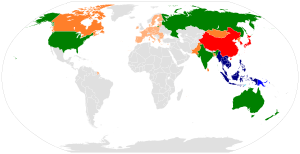In November 2010, the State Intellectual Property Office of China outlined broad economic objectives and specific targets to be attained by 2015 through the use of new patents.
The document, titled “National Patent Development Strategy (2011-2020)” revealed China’s intention to power the development of its economy not through low-cost manufacturing, as it had in the past, but through the use of a new tool – innovation.
This is not a new strategy. At the recent ASEAN Regional Entrepreneurship Summit, US Secretary of State Hilary Clinton pinpointed the innovation and creativity of young entrepreneurs in Indonesia can help the government solve the problem of providing jobs to the 75 million Indonesians currently under the age of 18 . What makes the notion of innovation as an economic lever interesting is that it represents a substantial change in traditional Chinese economic planning.
Only ten years ago, Asia was the world’s hinterland, merely a secondary market to North America and Europe. The rise of the twin powerhouses of China and India, as well as the explosive growth of other developing economies has brought renewed attention to the region. Asia is the hub of new technological developments like the focus on cloud technology, driven by the changing face of the Internet and the rapid uptake of mobile phones in Asia. Businesses in Asia, particularly technology businesses, are reaping the benefits of Asian receptiveness to technology and early adopter mindset, particularly in countries like Korea, Japan and Singapore.
For China to target innovation is a great step in a very different direction, for a country whose greatest strength was once its ability to manufacture goods cheaper than any other. And this will be a great shift – there were 300 thousand patent filings in China in 2009, but the new plan calls for this number to rise to 2 million per year by 2015 . China’s recent patent filings in the United States also match this strategy for national development, in fields that China has declared as priorities, including solar and wind energy, information technology and telecommunications, and battery and manufacturing technologies for automobiles.
Other commentators have also noted this shift in China’s strategy: in its August report titled “Patented in China: The Present and Future State of Innovation in China”, ThomsonReuters’ Eve Y. Zhou and Bob Stembridge concluded that “an epic industrial revolution has brought China to its current state of development, but it will be China’s intellectual revolution that will carry it forward”.
But will pressuring its people to create more patents be enough? Forbes’ Bill Fischer describes the limitations of the innovation strategy, saying that a nation’s firms must not only innovate, they must capture the economic value of innovation. That task includes creating the infrastructure to support innovation, as well as enabling companies (including both startups and established enterprises) to research, develop, and bring viable innovations to market.
Not an easy task, when China is located amidst a raft of other countries who are also banking on innovation. Take Thailand, not traditionally known for its computer science wizards, but where the enterprise applications market grew at 13.7 percent year on year in 2010. This is following 20.6 percent growth in 2009 according to IDC’s Asia/Pacific Semiannual Enterprise Applications Tracker. At this rate, the enterprise applications market in Thailand is expected to be worth US$187 million by 2015, assuming a five-year compound annual growth rate of 12.5 percent. With an enviable 15percent market share, Thailand is the third largest market for enterprise applications in ASEAN, behind Singapore and Malaysia.
It is realising the value of innovation that will be China’s greatest challenge, as it races to take advantage of the massive innovation potential in Asia. Creating an entrepreneurial culture could be a substantial challenge, but China has faced such challenges before. It took only two decades for China to go from being a poor economy to the manufacturing giant that it is today, and now, only a decade since, China is poised to reinvent itself yet again. The problem may not simply be one of incentivizing the creation of new products and services, but of making the right connections. Startups and other innovators will need to identify venues and opportunities to show off their ideas, in the hopes of attracting sufficient funding to help mature those ideas and bring them to a market-ready state.
Bookmark this page for “China’s new frontier” and check back regularly as these articles update on a very frequent basis. The view is set to “news”. Try clicking on “video” and “2” for more articles.









